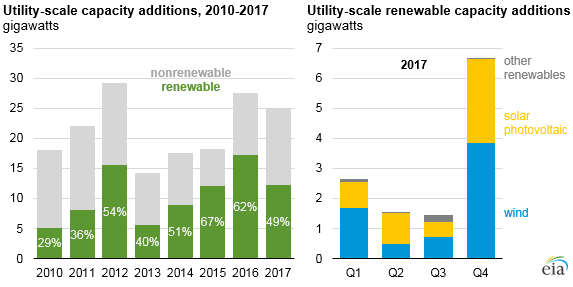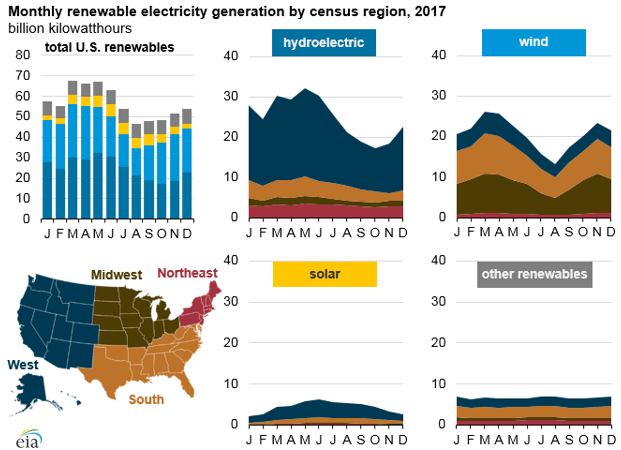Once final data are in, the U.S. Energy Information Administration (EIA) expects about 25 GW of new utility-scale electric generating capacity to have been added to the U.S. power grid during 2017, nearly half of which use renewable technologies, especially wind and solar. According to an analysis from the agency, another 3.5 GW of small-scale solar net capacity additions are estimated to have come online in 2017.
Of the renewable capacity additions in 2017, more than half came online during the fourth quarter. As the EIA explains, renewable capacity additions are often highest in the final months of the year, in part because of timing qualifications for federal, state, or local tax incentives. Estimated fourth-quarter capacity additions for 2017 are based on planned additions reported to the EIA and are subject to change based on actual project completions, the agency notes.

Monthly U.S. renewable electricity generation peaked in March, at 67.5 billion kWh, or 21% of total utility-scale electricity generation. In late spring, the melting snowpack from a winter characterized by higher-than-average levels of precipitation increased hydroelectric generation, while strong wind resources in March also produced a peak in monthly wind generation for the year.
The EIA says most renewable generation in 2017 came from the Western census division, which accounted for the majority of the hydroelectric (67%) and solar (69%) generation. Wind generation was more evenly spread across the country in 2017, with 37% occurring in the Midwest, 37% in the South, 21% in the West, and the remaining 4% in the Northeast.

According to the EIA, other renewable electricity highlights in 2017 included the following:
- In February, Maryland increased the renewables generation target in its renewable portfolio standard (RPS) to 25% of retail electricity sales by 2020, replacing the earlier target of 20% by 2022;
- For the first time, monthly electricity generation from wind and solar (including utility-scale plants and small-scale systems) exceeded 10% of total electricity generation in the U.S. in March;
- In early spring, California’s total solar share of gross electricity demand exceeded 50% during the mid-day hours, resulting in negative pricing;
- From March through May, U.S. monthly electricity generation from utility-scale renewable sources exceeded nuclear generation for the first time since July 1984.
- On Aug. 21, a solar eclipse obscured the sunlight needed to generate electricity at approximately 1,900 utility-scale solar photovoltaic (PV) power plants in the U.S. Solar power output in the California Independent System Operator (CAISO) region fell to a low of 3.6 GW during maximum obscuration, about 60% lower than normal.




